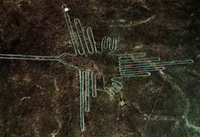 BBC reported 20 January 2000, about the
discovery of the lost Nazca city, Cahuachi. As BBC put
it in the article, the city emerged as a treasure trove of the Nazcan
culture (BBC-link: www.bbc.co.uk/science
).
BBC reported 20 January 2000, about the
discovery of the lost Nazca city, Cahuachi. As BBC put
it in the article, the city emerged as a treasure trove of the Nazcan
culture (BBC-link: www.bbc.co.uk/science
).
The Nazca lines are geoglyphs and geometric
lines appearing in the Peruvian desert. They were made by the Nazca people
for more than 1500 years ago. Today
the giant
drawings are one of Peru's main tourist attractions and have been
declared a ''world cultural heritage site'' by the United Nations Educational,
Scientific and Cultural Organisation (UNESCO).
The desert itself runs for over 1,400 miles along the
Pacific Ocean. The area of the
Nazca art is called the Pampa Colorada (Red Plain). It`s 15 miles wide and runs
some 37 miles parallel to the Andes and the sea. The dark red
surface of stones and soil have been cleared away, exposing the lighter
coloured subsoil, creating the fantastic huge lines. There is no sand in this
desert. From the air, the lines include not only lines and geometric shapes, but
also depictions of animals and plants in stylized forms. Some of the forms
includes images of humans (or could some of the be of aliens???).
Several theories
have been made about the Nazca lines. The most famous Nazca researcher is Maria
Reiche, the German mathematician and archaeologist. She died in 1998 at the age
of 95. She believed that the lines were an Astronomical Calendar.
The world famous scientist and author Erich
von Däniken connect the lines to visitors from other planets. Like in the
modern religious cults, the Nazca people tried to call the
Gods by drawing lines, figures and trapezes. He believe that the area,
which is covered by lines, was used as an landing stripe for aliens in the
past.
Based
on Orefici and his team excavations, it has been found paintings
on preserved pottery, and the ancient technique of weaving that the Nazca people
developed. These have given an insight into how the lines may have been made,
and what they might have been used for.
Most exciting is
the discovery of human remains. In the dry soil of the Peruvian desert the
team have found well preserved mummified bodies of the Nazcan people themselves.
Originally believed to have been a military stronghold, Cahuachi is now believed to be a
place of ritual and ceremony, and Orefici's stunning new evidence confirms this
idea.
There is also other evidence that the lines were
for ritual walking. On the opposite side of the pampa from Cahuachi
archaeologists have made a further unique discovery: they found
another big Nasca settlement called Ventilla!
Although Ventilla has been partially destroyed
by farming there was enough evidence to show that this was a genuine urban city,
not a ritual centre like Cahuachi. One long Nasca line links Ventilla with
Cahuachi. It seems likely this was a pilgrimage route between the two very
different sites and there is powerful evidence that points to another purpose
for many other lines. It's linked with the most precious commodity in the Nazca
region.
Cahuachi is now revealed to have been abandoned after a
series of natural disasters destroyed the city. But before they left it, the
Nazcan people covered the city in the arid pampa sand where, until recently, it
has remained a barely visible mound in the desert. Fortunately
are the images well preserved too, so the study of the great mystery can go
on!
Images of the Nazca
lines:
1. Killer
Whale
2.
Wing
3. Baby
Condor
4.
Bird
5.
Animal
6.
Spiral
7.
Lizard
8.
Tree
9.
Hands
10.
Spiral
11.
Spider
12.
Flower
13. Dog
14.
Astronaut
15. Triangle
16. Whale
17.
Trapazoids
18.
Star
19.
Pelican
20.
Bird
21.
Trapazoid
22.
Hummingbird
23. Trapezoid
24. Monkey
25. Llama
26. Trapezoids
I still wonder:
how could ancient people make these images since it`s only possible to view
them from air?
Stein Morten Lund, 25 January 2000.
Additional information
Some facts about the
country:
- Formal country name:
Republic of
Peru.
- Area: 1.28 million sq
km.
- Population: 28
million.
- People
: 54% Indian, 32% Mestizo (mixed European and Indian
descent), 12% Spanish descent, 2% Black, Asian minority
- Language: Aymara, Quechua, Spanish;
Castilian.
- Religion: Over 90% Roman Catholic,
small Protestant population.
- Government: constitutional
republic.
Read more about Peru
on our website:
- The a
ncient Inca capital of
Cuzco.
- Explore the lost city of
Machu Picchu.
- Experience the country`s beautiful
scenery, the Peruvian Andes.
- Visit home to some of the millions of highland
Indians who still speak the ancient tongue of Quechua and maintain a traditional
way of life.
- Get an adventure of life in the
Amazon
Basin, which
occupies half of Peru. Look
up for the puma!
